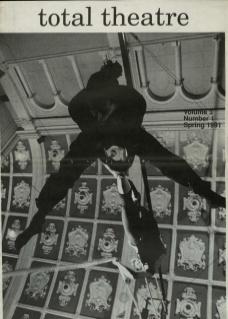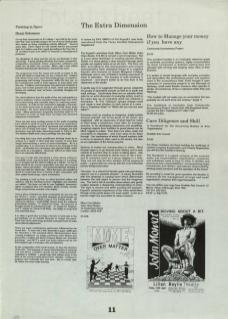On my final assessment at art college, I was told by the senior tutor that I was ‘probably going to be one of those horrid people who ended up doing something entirely different’. Several years later, I don’t regret for one minute that he was proved right, for I believe now that a good grounding in the Fine Arts is an excellent basis from which to become a mime/physical performer.
The disciplines of mime and fine art are not dissimilar in their structuring. A good painting demands that shape, perspective, composition, movement, colour, expression, ambience and depth are all taken into account. Mime, with a few added theatrical and dramatic dimensions, demands the same.
The progression from the visual arts world on paper to the visual arts world on stage was, for me, a natural one. I believe that where there were once flourishing groups of painters, progressing and forming ‘movements’ within the fine arts, so the contemporary world of mime appears to have taken over this role. Traditions and techniques may date back hundreds of years, but in their present role at least, mime and physical theatre are relatively ‘new’ art forms, constantly changing and developing
The visual influence from the world of fine arts and graphics is much in evidence; cartoon animation being perhaps one of the most interesting and valuable ways for exploring mime movements. In order for the cartoonist to animate a character, so he must know how to analyse and break down body movement – the mime performing illusions must know the same. Mime performers frequently lend their skills to TV animators in order to help them recreate and structure sequences of movement.
There are also many exciting sources in the world of painting from which to draw (if you’ll pardon the pun) inspiration. Kandinsky’s paintings are full of movement and animated with clever use of shape and colour. Picasso’s paintings and lurid characters may well make interesting people to ‘bring to life’. The Northern Ballet took Lowry’s paintings onto the stage.
One thing that many mime practitioners devising shows try to achieve is a depth to their work that consists of more than simply demonstrating a series of clever techniques. As in a scripted play, it is necessary for there to be meaning in the show – constructed from movement and physical ability, rather than words, as a foundation. Obviously, without an initial script, this is an extremely difficult task.
One way to help with structuring a show whose content is essentially visual may be to look at the structure of a painting. Let us imagine that the artist is setting up a still life. He has to think ahead to his overall composition and take into account shape, colour and texture. The performers/director devising a show start with the initial idea. What the piece will actually be about is constructed from a mixture of plot, characters, and other added detail (shape, colour and texture).
The painting is built up from an initial sketched outline and added to until the ‘finishing touches’ (highlights and shadows) are added. The show can add its own ‘highlights’ (humorous, lighter or poignant bits) and ‘shadows’ (black comedy, secrets things not previously revealed, more depth).
Once a piece of theatre has been constructed, we can now add the ‘M.U.S.T.’ factor – essential elements of good theatre as suggested/devised by Mark Long of The People Show. ‘M’ represents Mystery – predictability doesn’t keep the audience particularly riveted. ‘U’ stands for Unity – the process of thought should be followed through. ‘S’ stands for Surprise, and ‘T’ stands for Throw It All Away – the ability to scrap tired and outmoded ideas.
It is often a good idea to bring a director in fairly late in the proceedings, as an outside observer to ‘shape’ the piece. Think here of the artist lining up thumb and paint-brush to make observational judgements!
There are many contemporary performers influenced by the Visual Arts. To name but a few: Marchetto’s paper outfits give his characters a 2D, animated effect; Mummenschanz have ‘moving sculptures’ on stage; performer John Mowat was previously a sculptor; the dance company Momix use ‘animated paintings’; and MTP’s work has been influenced by the technological age of animation, film and television
As the complexities of the world change, so does the structure of the arts. The language of visual communication is universal and one which I believe should not go undernourished, neglected or stultified. I would hope that artistes (even in the face of the current political economic climate), continue to progress and continually form new work – this is a world, after all, where one never stops learning.

